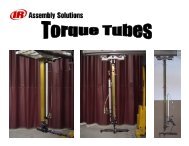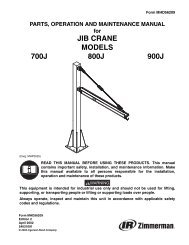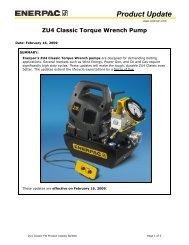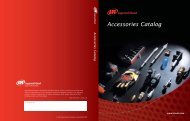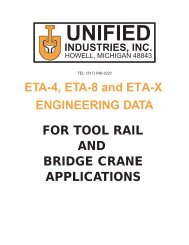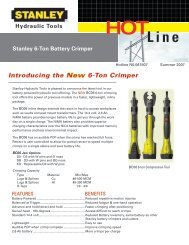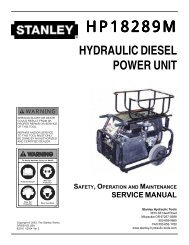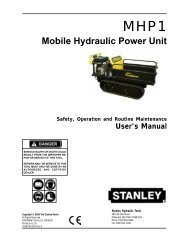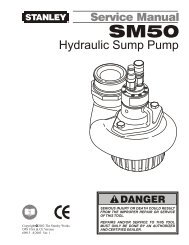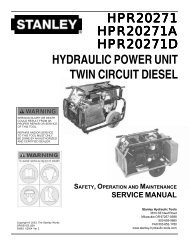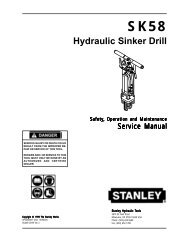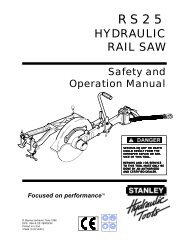CraneBrdgKit CatNos904535 904536 904538 - 113535 ... - Tool-Smith
CraneBrdgKit CatNos904535 904536 904538 - 113535 ... - Tool-Smith
CraneBrdgKit CatNos904535 904536 904538 - 113535 ... - Tool-Smith
You also want an ePaper? Increase the reach of your titles
YUMPU automatically turns print PDFs into web optimized ePapers that Google loves.
CAUTION<br />
Do not substitute standard bolts and nuts for the special<br />
truck connecting bolts and nuts furnished with kit. Only<br />
high-strength bolts (S.A.E., grade 5) and elastic collared<br />
self-locking nuts, as furnished, are acceptable for attaching<br />
truck frames to bridge beam. High strength bolts are identified<br />
on the top of the head by three radial lines, equally spaced<br />
at 120 degrees. Self-locking nuts must have two threads,<br />
minimum extending thru nut. If necessary, discard flat<br />
washer to get two threads.<br />
12. For bridge beams over 7", bolt short angle welded at truck to<br />
bridge beam web with four (two at each end of bridge) 5/8"<br />
diameter bolts furnished with kit. Tighten using turn-of-nut method.<br />
13. Optional End Connection for 6", 7" and 8" Beams Only.<br />
a. Drill 4 holes 41/64" diameter thru bridge beam lower flange and<br />
truck flanges in locations shown in Figure 6 at both ends of<br />
bridge.<br />
b. Assemble beam to truck using eight (four at each end of bridge)<br />
5/8" diameter bolts furnished with kit. Put beveled washer under<br />
bolt head and against I-beam flange. Use self-locking nut (no flat<br />
washer) and tighten using turn-of-nut method.<br />
14. Mount trolley stops to I-beam web in position shown in Figure<br />
7. Stops may be welded or bolted in place. If bolted, drill holes<br />
using 21/32" diameter drill as indicated in Figure 7. 5/8" diameter<br />
bolts with self-locking nuts should be used to secure stops.<br />
15. If it is desired to increase the rigidity of the bridge, four angles<br />
(one to each corner) may be added in the position shown as<br />
“Optional” (at 45° to the bridge I-beam) in Figure 7. On a motor<br />
driven crane it may be necessary to move the electrical enclosure<br />
for clearance reasons.<br />
INSTRUCTIONS FOR ASSEMBLING<br />
PUSH BRIDGE WITH UNCOPED GIRDER<br />
1. Turn Beam over on supports with camber side up. When<br />
setting up beam on supports, make certain that the bottom flange<br />
is level as shown in Figure 5. The larger wheel flange goes inside<br />
the span.<br />
2. Position girder mounting plates on top of each truck center<br />
plate and clamp securely. Drill 4 holes 41/64" diameter through<br />
truck center plate and flanges of truck channels using holes in<br />
girder mounting plate as template.<br />
3. Assemble girder mounting plate to top plate of each truck using<br />
eight (four at each end of bridge) 5/8" diameter high strength<br />
grade 5 bolts furnished with end connection kit. Put one flat<br />
washer under bolt head and one under the self locking nut.<br />
Tighten all bolts and nuts using the turn-of-nut method. This is<br />
done by alternately bringing bolts and nuts to a "snug-tight"<br />
condition to ensure that mating surfaces are brought into full<br />
contact with each other. Then, make a final ½ turn on all bolts and<br />
nuts.<br />
4. Set up, square, block and securely clamp trucks into position<br />
as shown in Figure 6. Make certain trucks are level with each<br />
other and are level with bottom flange of bridge beam as shown<br />
in Figure 5 (it is possible that top flange of beam may not be level<br />
even though bottom flange is). When leveling trucks use either<br />
the centerline of the wheel axles or the diameter of the wheels.<br />
DO NOT LEVEL FROM TRUCK STRUCTURE. Correct operation<br />
of hoist-trolley requires that the bottom flange be level.<br />
5. Square end truck to end of bridge beam at one end of beam.<br />
Make sure trucks are parallel by measuring outside of wheel<br />
flanges across span at both ends of truck with end play for all<br />
wheels taken up in one direction.<br />
6. Check center to center of trucks. This may be done by<br />
measuring from the inside edge of the truck at one end of the<br />
bridge to the outside corresponding edge of the truck at the other<br />
end of the bridge. This should equal the span length.<br />
7. When all dimensions are confirmed, bottom flange of bridge<br />
beam is parallel to wheels of truck and truck is securely clamped<br />
to bridge beam, weld the girder bottom flange to the girder<br />
mounting plate as shown in Figure 6.<br />
8. Cut 3/8" girder end cap plate and weld to end of girder and<br />
girder mounting plate as shown in Figure 6.<br />
9. To provide rigidity to the bridge, four braces (one to each<br />
corner and one to girder web parallel to truck) may shall be added<br />
in the position shown in Figure 7a. On an motor driven crane it<br />
may be necessary to move the electrical enclosure for clearance.<br />
10. Mount trolley stops to beam girder web in position shown in<br />
Figure 7. Stops may be welded or bolted in place. If bolted, drill<br />
holes using 21/32" diameter drill as indicated in Figure 7. 5/8"<br />
diameter bolts with self-locking nuts should be used to secure<br />
stops. Stop material by customer.<br />
INSTRUCTIONS FOR ASSEMBLING<br />
HAND GEARED CRANE BRIDGE<br />
1. Follow instructions for assembling the appropriate push crane<br />
bridge.<br />
2. Locate and drill holes for cross shaft supports.<br />
3. Bolt the cross shaft support angles to the bridge beam. The flat<br />
washer goes under the bolt head and the beveled washer goes<br />
between the beam flange and the lockwasher and nut.<br />
4. Attach a flange bearing to each cross shaft support plate with<br />
two carriage bolts, lockwashers and hex nuts. The carriage bolt<br />
head locks in the bearing (see Figure 13).<br />
5. Place the proper number of bearings and couplings on the<br />
cross shaft, set the unit in place and clamp the cross shaft support<br />
plates to the cross shaft support angles. The hand chain wheel<br />
and chain guide must also be placed on the cross shaft before<br />
placing. They may be positioned anywhere across the span, but<br />
must be within 12" of a cross shaft support or truck.<br />
6. Check horizontal alignment of the cross shaft by using a taut<br />
line. Weld plates to angles when alignment is complete. Weld as<br />
shown in Section A-A of Figure 7.<br />
7. Check the space between ends of cross shafts; it should be<br />
1/8". Position the couplings and drill 1/4" diameter holes through<br />
the shaft and coupling using the holes in one side of the coupling<br />
as a guide. Shaft and coupling is secured by socket head cap<br />
screws with flat washers and self-locking hex nuts (see Figure<br />
14). Tighten set screws in flange bearings.<br />
8. Set position of hand chain wheel and chain guide (within 12"<br />
of cross shaft bracket or truck) with set screw on hand chain<br />
wheel. Determine length of operating hand chain (chain should<br />
hang about 2 feet 6 inches above floor), cut chain and make it<br />
endless by installing and closing open link furnished with chain.<br />
Page 15



